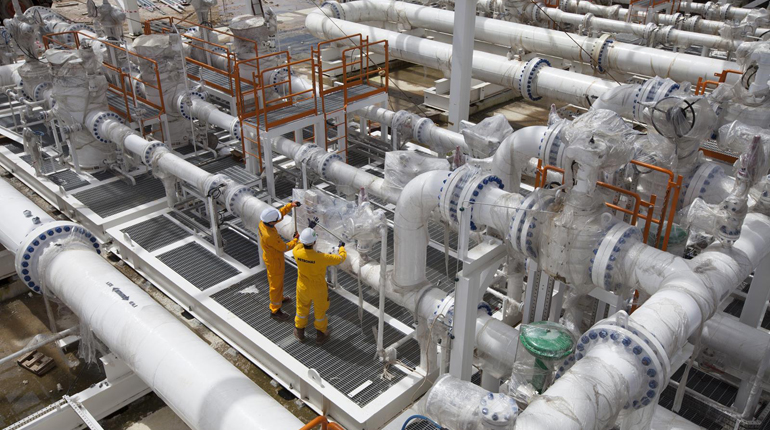Political upheaval rattles Malaysia’s Petronas
Against a background of political turmoil, Malaysia’s NOC is trying to invest in future projects and maximise revenues despite low oil prices.
 Petronas’s Sabah oil and gas terminal. Malaysia is suffering from the worldwide oil price slump. (Petronas)
Petronas’s Sabah oil and gas terminal. Malaysia is suffering from the worldwide oil price slump. (Petronas)
Petronas could have more to worry about than just low oil prices. The extended slump in global crude benchmarks is weighing on Malaysia’s NOC as it juggles investing in long-term projects for future growth with meeting its dividend obligations to the government.
Concerns are rising that the government will need to tap Petronas for more money to bolster Malaysia’s flagging economy. Any increased dividend payouts could affect the NOC’s ability to drive forward its future investment plans, which include a major LNG export scheme in Canada as well as smaller domestic projects.
Malaysia is not as dependent on oil and gas as it once was, although hydrocarbons still bring in around 15-20% of the nation’s revenues. However, lower oil prices mean Southeast Asia’s third-largest economy will still be confronted with significant obstacles to growth and fiscal headwinds.
Weak international oil prices, trading around $30-35 per barrel, are squeezing the finances of Asia’s only major net oil exporter. The drop in the Malaysian ringgit – which was Asia’s worst-performing currency last year, when it slumped to a 17-year low and lost around a quarter of its value against the dollar – is not helping either.
In recent years the government has acknowledged Petronas’s desire to save and reinvest in its operations. But things are looking increasingly desperate for Prime Minister Najib Razak’s government, Wan Saiful Wan Jan, chief executive of Kuala Lumpur-based political thinktank the Institute for Democracy and Economic Affairs, told Natural Gas Daily.
Aside from the economic turmoil, Razak remains embroiled in a growing embezzlement scandal that threatens to bring simmering civil and political tensions to the boil. Malaysia’s political system follows the ‘development politics’ model, in which the government has to keep spending to maintain popular support even though its finances are stretched.
At the same time, there have been ongoing requests for higher oil and gas royalty payments from the country’s regional governments, including Sabah and Sarawak in East Malaysia, as well as Kelantan and Terengganu in Peninsular Malaysia.
Before the political scandal, the federal government dismissed the demands, but it is increasingly difficult for it to keep doing so. "If [Razak’s party] decided to stop supporting him then his days could literally be over, so he will have to concede somewhat" said Wan.
The government has two options to boost its coffers. First, it could milk Petronas for more money. Second, it could instruct other government-linked companies to pay dividends and invest more domestically.
"I doubt Petronas can safely assume that it will not be touched. It will be a major challenge for the chief executive to safeguard the NOC’s interests in the current political climate," added Wan.
Petronas said in January that it would cut operating and capital expenditure by at least $12 billion over the next four years in the wake of plunging oil prices. Subbu Bettadapura, a Malaysian specialist with consultancy Frost & Sullivan, estimates Petronas will now allocate about $10-12 billion on capital spending every year for the foreseeable future.
Pacific NorthWest delay
Bettadapura told NGD that he expects the NOC will delay taking an FID on its $36 billion, 12 mtpa Pacific NorthWest LNG project until around 2022, once the LNG glut on the global market has cleared. Petronas, a 62% shareholder in the scheme, would need to borrow at least $5-7 billion to help fund construction.
From a cost standpoint there may never be a better time for Petronas to build an LNG plant in Canada. The development would benefit from the weak Canadian dollar, low steel costs, declining oil sands activity and an expanding labour pool.
Any delay could open the possibility of a negotiated exit for one or more of the partners, which include Sinopec, China Huadian, Japan Petroleum Exploration Corp., Indian Oil Corp. and Petroleum Brunei, said Canada-based analysts at Wood Mackenzie. "This would jeopardise the equity offtake agreements, which form the basis for more than a third of Phase 1 production, excluding Petronas’s share," they said.
The main risk appears more a question of whether Petronas can win the approval of First Nations groups with titles to Lelu Island, the plant’s proposed location. The project will proceed if agreement is reached quickly, says Woodmac.
At home, Petronas will not push ahead with developing Malaysia’s deepwater fields unless oil prices rise above $60/bbl, the breakeven price of the fields, Bettadapura said.
Meanwhile, the startup of Petronas’s Refinery and Petrochemicals Integrated Development – which includes a 300,000 b/d refinery and an LNG hub – will be delayed by 6-12 months until late 2019, he added. The company will invest $27 billion in the project over the next five years.







